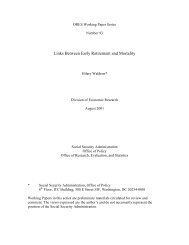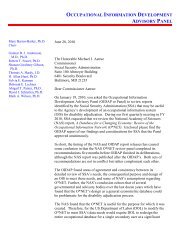the population that would need to change occupationsso that groups A and B had similar distributions.The next step is to estimate the occupationaldistributions under the assumption that no differencesexist between the two groups. As with other studies ofoccupational choice (for example, Miller and Volker(1985); Brown, Moon, and Zoloth (1980); Gabrieland Schmitz (2007); Gabriel, Williams, and Schmitz(1990)), a multinomial logit model of occupationalchoice is estimated on a comparison group (for example,the sample of nonrecipients without a disability)controlling for observable characteristics (see Schmidtand Strauss (1975)). This model is based on randomutility theory where individual i potentially gainsutility U from each occupation j equal to―(2) U = b¢ Z + e .ij ij ijThe Z vector incorporates all relevant individualcharacteristics. Assuming an individual would choosethe occupation that offers the highest level of utility,the probability of individual i choosing occupation jtakes the general form of―b¢Zije(3) Pr( Yi= j)=.Jb¢Zijeåj=1The dependent variable identifies the occupationgroup of the individual. 13 In this study, the baseoccupation is office and administrative support,which comprises the largest single occupation group.Characteristics controlled for (the Z vector) includedemographic characteristics: sex (men versus women),Hispanic ethnicity (Hispanic versus non-Hispanic),race (white versus nonwhite), marital status (marriedversus nonmarried), age, and age squared. Also controlledfor are human capital characteristics: education(more than high school but less than college, college ormore versus high school or less, or missing). Althoughthis is a parsimonious model, it is limited by the factthat few other variables are available in the data setthat would be expected to better explain occupationchoice. 14The estimated coefficients are used to obtain thepredicted probability of occupation j for individual i ineach of the other groups (that is, working SSI recipients,nonrecipients with a disability, and nonrecipientswith a work disability). These probabilities are thensummed to estimate the fraction of individuals ineach group in each occupation. Note that this is notequivalent to assigning each individual an occupationbased on the highest predicted probability. Using thehighest predicted probability would result in a lossof valuable information if there are small differencesbetween predicted probabilities of different occupations.Additionally, if there are several occupations oroccupations with very low probabilities, they wouldnever be represented in the estimated distributions.The dissimilarity index between the actual distributionsof two groups reflects how different theoccupational distributions are between those groups.Dissimilarity indices can also be calculated betweenthe actual distribution of one group and the distributionof another group under the model of the first group;that is, the coefficients from a multinomial logit modelpredicting the occupational distribution of group A areapplied to group B and the index is calculated fromthe actual distribution of group A and the estimateddistribution of group B. Typically, any residual differencehas been interpreted as a measure of the level ofdiscrimination against one group. However, personalpreferences, inadequate (specific) training, physical,cognitive, and mental limitations, or, especially withthe population with disabilities, insufficient supportsmay also result in a nonzero dissimilarity indexbetween the actual and predicted distributions. 15This process is repeated using the characteristicsof the nonrecipients with disabilities, nonrecipientswith work disabilities, and working SSI recipients toestimate occupational distributions of each group.However, an expanded model for these groups isestimated, which includes indicators of the type of disabilityto control for any disability-specific limitationsin occupational opportunities.Thus, predicted occupational distributions for eachgroup, according to each of the other group’s decisionmodels, can be compared with the actual occupationaldistribution of the other groups. This can answer twoimportant questions: First, what occupations would thedisabled (or disabled SSI recipients) have if they werenot disabled (or disabled SSI recipients), controlling fordemographic and human capital characteristics? Andsecond, conditional on having a disability and controllingfor the type of disability and other demographicand human capital characteristics, what occupationswould SSI recipients have if they did not receiveSSI payments? Note that this methodology is based<strong>entire</strong>ly on observable factors. Large differences in theoccupational distributions could remain after controllingfor observable factors if there are unobservabledifferences in the populations or their environments.This is discussed further in the Discussion section ofthis article.52 <strong>Social</strong> <strong>Security</strong> Bulletin • Vol. 69 • No. 3 • 2009
Occupational Distributions of theEmployedThe actual occupational distributions for the fouremployed populations are presented first and thencompared with each other, focusing on comparisonswith the working SSI population. This is followed bycomparisons of predicted occupational distributionsfrom the model(s) described above.Actual DistributionsTable 1 presents the actual occupational distributionsfor the four employed population groups. 16 The differencesin the occupational distributions between thegroups can easily be seen. Generally, lower fractionsof working SSI recipients are employed in occupationswith higher fractions of nonrecipients, and vice versa.The occupational distributions of the nonrecipient populationswith any disability and with a work disabilityTable 1.Actual occupational distributions of the employed populationOccupationNon-SSI recipients with—SSI recipients No disability Any disability Work disabilityPercentageerror age error age error ageStandard Percent-Standard Percent-Standard Percent-StandarderrorTotal 100.00 . . . 100.00 . . . 100.00 . . . 100.00 . . .Management, professional, and related 9.51 . . . 35.62 . . . 25.87 . . . 23.48 . . .Management 1.70 0.28 9.88 0.03 6.94 0.11 5.86 0.22Business and financial operations 1.48 0.25 4.55 0.02 3.15 0.08 3.03 0.15Computer and mathematical, architectureand engineering, life, physical andsocial science 0.25 0.09 5.45 0.02 3.64 0.07 2.93 0.14Community and social services 1.60 0.28 1.58 0.01 1.71 0.05 1.56 0.11Legal 0.33 0.13 1.17 0.01 0.74 0.04 0.67 0.06Education, training, and library 2.02 0.33 5.84 0.02 4.32 0.08 3.78 0.14Arts, design, entertainment, sports, andmedia 1.06 0.22 1.92 0.01 1.43 0.05 1.53 0.11Health-care practitioner and technical 1.07 0.23 5.23 0.02 3.93 0.08 4.12 0.17Service 33.60 . . . 15.97 . . . 20.53 . . . 22.76 . . .Health-care support 1.72 0.30 2.20 0.01 2.95 0.07 3.22 0.16Protective service 1.31 0.28 2.10 0.02 2.11 0.07 2.26 0.13Food preparation and serving related 9.75 0.67 4.99 0.03 5.74 0.12 6.20 0.23Building and grounds cleaning andmaintenance 14.54 0.98 3.58 0.02 5.80 0.13 6.49 0.25Personal care and service 6.27 0.55 3.10 0.02 3.93 0.08 4.60 0.19Sales and office 21.71 . . . 25.15 . . . 25.54 . . . 24.44 . . .Sales and related 8.66 0.76 11.00 0.03 10.65 0.15 10.65 0.28Office and administrative support 13.05 0.69 14.15 0.04 14.89 0.15 13.79 0.30Farming, fishing, and forestry 0.84 0.21 0.67 0.01 0.73 0.04 0.75 0.07Construction, extraction, maintenance, andrepair 3.90 0.44 10.02 0.04 10.92 0.13 11.22 0.31Production, transportation, and materialmoving 30.45 . . . 12.57 . . . 16.43 . . . 17.36 . . .Production 15.68 0.97 6.64 0.02 8.33 0.14 8.33 0.25Transportation and material moving 14.78 0.86 5.94 0.03 8.09 0.12 9.03 0.27N (unweighted) 2,745 1,180,588 72,686 18,414N (weighted) 311,838 123,408,821 7,432,897 1,852,399SOURCE: Author's calculations using the 2007 American Community Survey using balanced repeated replicate sample weights.NOTES: The sum of individual categories may not equal the total because of rounding.. . . = not applicable.<strong>Social</strong> <strong>Security</strong> Bulletin • Vol. 69 • No. 3 • 2009 53
- Page 1 and 2:
Social SecuritySocial SecurityBulle
- Page 3:
Social SecurityBulletin Vol. 69, No
- Page 6 and 7:
Perspectives77 An Empirical Study o
- Page 8 and 9: Selected Abbreviations—continuedM
- Page 10: within the next few years (Aglira 2
- Page 14 and 15: coverage varies significantly by ra
- Page 16 and 17: non-Hispanic white, and college edu
- Page 18 and 19: same groups (Table 6). For the last
- Page 20 and 21: from DB to DC pensions is accelerat
- Page 22 and 23: Table 8.Percent of individuals who
- Page 24 and 25: not necessarily the largest gains a
- Page 26 and 27: shoring-up DB plans before those pl
- Page 28 and 29: Table B-1.Percent change in mean pe
- Page 30 and 31: Table B-3.Percent of individuals wh
- Page 32 and 33: ReferencesAaronson, Stephanie, and
- Page 35 and 36: Social Security Administration’s
- Page 37: Chart 1.Historical expansion of Soc
- Page 40 and 41: self-employment information for the
- Page 42 and 43: (Cronin 1985). The final earnings r
- Page 44 and 45: prior to 1950, first year of earnin
- Page 46 and 47: average indexed monthly earnings (A
- Page 48 and 49: 13For an explanation of how the sel
- Page 50 and 51: Kopczuk, Emmanuel Saez, and Jae Son
- Page 53 and 54: Occupations of SSI Recipients Who W
- Page 55 and 56: on the differences between the occu
- Page 57: prediction models. Table A-1 lists
- Page 61 and 62: similar, only 4 percent of the popu
- Page 63 and 64: Table 5.Estimated occupational dist
- Page 65 and 66: Table 7.Predicted Herfindahl-Hirsch
- Page 67 and 68: Table 9.Estimated occupational dist
- Page 69 and 70: Table 11.Average annual wages of wo
- Page 71 and 72: Table A-2.Means and standard errors
- Page 73 and 74: Table A-3.Coefficients and standard
- Page 75 and 76: Table A-3.Coefficients and standard
- Page 77 and 78: Table A-3.Coefficients and standard
- Page 79 and 80: management, professional, and relat
- Page 81: Stapleton, David C., Nanette Goodma
- Page 84 and 85: Selected Abbreviations—continuedO
- Page 86 and 87: The 1983 Amendments to the Social S
- Page 88 and 89: Chart 1.Proportion of new claimants
- Page 90 and 91: Table 4.The evolution of the ARF an
- Page 92 and 93: for the test of equality of means b
- Page 94 and 95: Table 8.Average monthly Social Secu
- Page 96 and 97: in the chart, especially for men, t
- Page 98 and 99: 6This is a very important character
- Page 100 and 101: Benítez-Silva, Hugo, Berna Demiral
- Page 103 and 104: OASDI and SSI Snapshot andSSI Month
- Page 105 and 106: Monthly Statistical Snapshot, Augus
- Page 107 and 108: Table 2.Recipients, by eligibility
- Page 109 and 110:
SSI Federally Administered Payments
- Page 111 and 112:
Table 7.Average monthly payment, by
- Page 113:
Awards of SSI Federally Administere
- Page 116 and 117:
Copyright—Authors are responsible
- Page 119 and 120:
Program Highlights, 2009Old-Age, Su








